A grommet or eyelet can make all the difference when you add the finishing touches to a garment. However, these two products are often confused because of their similar appearance and use. The confusion is so widespread that even some retailers use the two names interchangeably.
The main difference between grommet and eyelet is that grommets tend to be larger and more durable. They use two pieces of metal pressed together to strengthen the holes they protect. Eyelets, by comparison, tend to be small and lightweight, using only one piece of metal to reinforce a hole.
When it comes down to the comparison of grommet vs. eyelet, there are several more key differences to be aware of. In particular, you’ll also want to pay attention to the material, color, price, and installation process for each. Keep reading as we break down all of these differences and more.
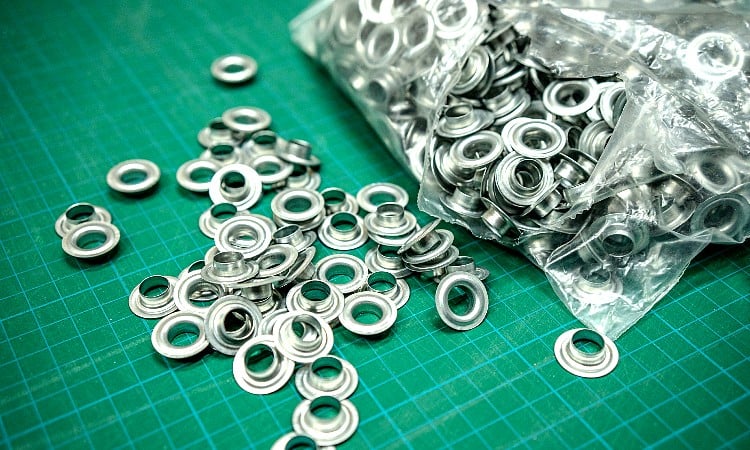
Quick Navigation
Grommet vs. Eyelet: Key Differences
| Grommet | Eyelet | |
|---|---|---|
| Material | Brass or stainless steel; other metals and even plastic options are sometimes available | Typically brass |
| Durability | Heavy-duty if made with brass or stainless steel | Not as durable; used mostly for decoration and lightweight applications |
| Colors | Typically silver or gold-toned; most colors available as well as even clear plastic options | Typically gold or silver; other metal tones are available |
| Sizes | Tend to be larger than eyelets, but can range in size from ⅛” up to 2” | Tend to be smaller than grommets; standard size is ⅓” but other sizes are available |
| Installation | Requires a grommet press machine or grommet pliers | Requires an eyelet press or eyelet pliers |
| Uses | Protect holes in curtains, boat sails, tents, outdoor flags, etc. | Protect holes for shoelaces, drawstrings, belts, and corset strings; decorative purposes |
| Price | Generally more expensive than eyelets; price varies according to size and material | Generally less expensive than grommets; price still varies by size and material |
What is a Grommet?

A grommet is a metal ring used to reinforce holes made in fabric to keep them from becoming larger over time. It is typically used in locations where a string, rope, chain, or other cord-like material will pass through a fabric. This way, the string will rub against the metal rather than the edges of the hole in the fabric.
Grommets tend to be sturdier than eyelets and are typically larger. You will often see them being used on fabric that will experience a lot of wear and tear. Flags hung atop flag poles, for example, will usually have grommets since they will hold up well as the flag moves in the wind.
Grommets are attached using two separate pieces pressed on either side of the fabric to trap the hole in between. The rings may have metal spikes to better grip each other and require specialized grommet tools to install.
What is an Eyelet?
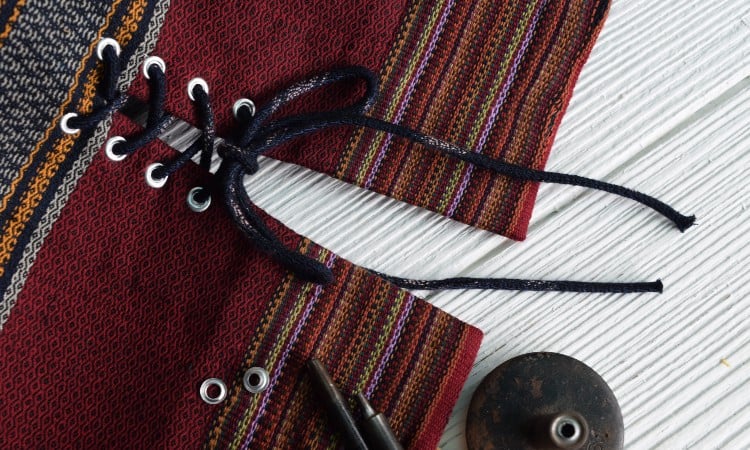
Eyelets are also used to reinforce holes, but typically not in locations that will experience a lot of wear and tear. Often, they are used for decorative purposes and may not necessarily have cords or strings passing through them. If they do, it will often be strings that don’t have to withstand a lot of pulling or pressure.
Eyelets tend to be smaller in size than grommets and are more lightweight. You’ll typically see them on your clothing, reinforcing holes for things like shoelaces or drawstrings. They are also sometimes used in scrapbooking to reinforce holes in decorative paper.
True eyelets are attached using only one piece of T-shaped metal pressed to surround a hole. However, many smaller grommets are often mislabeled as eyelets because of their size. In these cases, you’ll always want to check to see if the product requires one piece or two to work.
Remember that one piece will mean it’s an eyelet. Two will generally mean it’s a grommet, even if it isn’t labeled as such.
What’s the Difference Between a Grommet and an Eyelet?
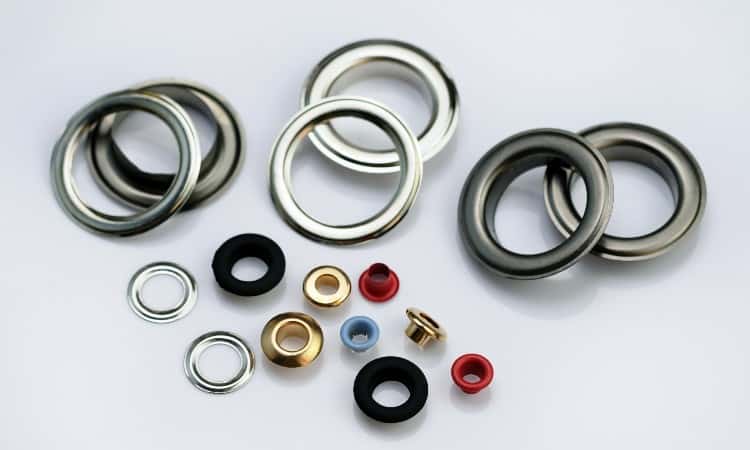
Material
Grommets tend to come in more materials than eyelets do, though brass and stainless steel are still the most common types. These metals are standard since grommets are typically meant to stand up to heavy-duty uses.
However, some manufacturers have started producing plastic grommets that snap together around a hole. Rubber grommets are also available, but these are typically used to protect electrical wires or other delicate materials passing through them.
Eyelets will almost always be brass, though they may be coated to look like copper, nickel, or other products. Other metal materials may be available, but true eyelets won’t come in plastic or rubber since these materials can’t be compressed on themselves to seal a hole.
Durability
Grommets are more durable than eyelets. Eyelets are usually only used on clothing or for decoration, while grommets are used in locations that will see a lot of wear and tear. Keep in mind, however, that some of the non-metal grommets may not be as durable as the standard brass or stainless steel options.
Colors
Grommets and eyelets are usually found in gold and silver tones and many other finishes like copper or nickel. Since eyelets are only metal, they tend to stick to only metallic finishes. Grommets, on the other hand, come in various colors to match any application they are used on.
Sizes
Grommets and eyelets come in various sizes, though most of the grommets you see will be larger than eyelets. That being said, grommets can range from between ⅛” to 2” in size.
Standard eyelets come as ⅓” in size, though you will often see ¼” or 3/16” options. Eyelets can still come in larger or smaller sizes than these but are not as common.
Installation
Both grommets and eyelets require special tools for installation. Not only will these tools grip the pieces of metal as they are installed, but they will also help provide even force to ensure proper installation.
Grommets usually require a tabletop press machine or a pair of grommet pliers to install. Some kits are available on the market that come with an anvil and setting tool that you use to hammer the grommet into place.
Eyelet installation usually requires a tabletop eyelet press machine or a pair of eyelet pliers. For crafters who may use both eyelets and grommets, many of these installation tools come with adaptable parts that will allow you to install both types of hardware.
Uses
Grommets tend to be used for more industrial or strenuous tasks. You’ll see them, for example, in places that receive a lot of wear and tear or hold a lot of weight. Boat sails, tents, and curtains are all places where you can expect to see grommets.
Eyelets tend to be used on clothing and for decoration. You will probably see them on clothes with drawstrings, corset ties, or even shoes with shoelaces.
Price
The price of grommets and eyelets will depend on their size and the materials used to make them. Grommets are typically made with sturdier metals and in larger sizes – meaning they tend to be more expensive.
Eyelets, on the other hand, are smaller and don’t require lots of heavy-duty metals to function. Because of this, they’re inexpensive in comparison – often costing just pennies a piece.
How to Use Grommets and Eyelets
Grommets and eyelets have limitless uses and can be applied to reinforce any holes you make in fabric. Their purpose is to allow cords, strings, or ropes to pass through the hole without damaging it or snagging on the fabric as they go.
Before you begin, you’ll need to decide whether you need to use a grommet or an eyelet. Remember that grommets work best for heavy-duty applications that will see a lot of wear and tear. Eyelets are mostly decorative or for fabrics that don’t see much tugging or pulling.
Then, you’ll need to decide what size of grommet or eyelet you’ll need. This will largely depend on what size string or cord you want to pass through the hole. A standard shoelace, for example, will work with a ¼” eyelet. However, specialty flat shoelaces can often be up to ¾” in width, which may require a larger hole to be made.
After that, you’ll need the proper tools to install your grommet or eyelet of choice. Grommet or eyelet kits may come with tools you can use to hammer them in place. Otherwise, you’ll need to consider investing in specialty grommet, eyelet pliers, or tabletop pressing machines.
Installing a Grommet
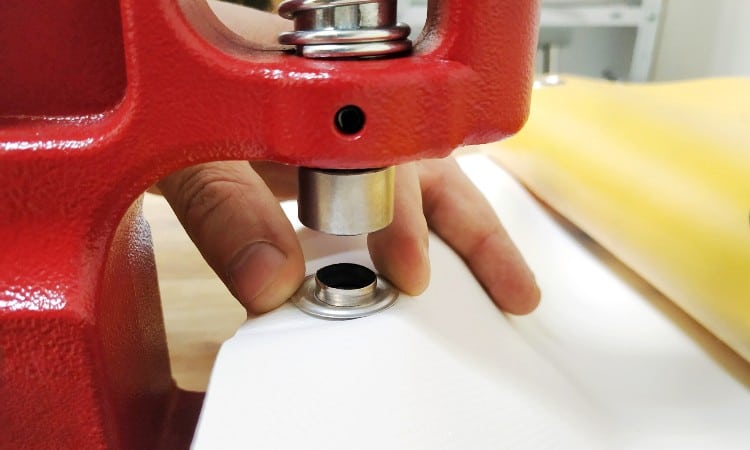
The first step to installing grommets is determining where you want them placed on your fabric. You’ll want to measure and mark so they are evenly spaced, keeping them at least ¼” away from the fabric’s edge.
Once you have marked your fabric, you’ll need to make a hole for the grommet to surround. If you purchased a grommet kit, check and see if it came with a tool to puncture a hole. Otherwise, manually cut a hole the same size as the interior of your grommet.
Then, you’ll need to insert the two halves of the grommet. One half will appear uniform on both sides, while the other will have a short shaft. The ring on the half with a shaft will go on the outside of your fabric.
Insert the grommet half through the hole with the shaft facing the interior of the fabric. Then, align the other piece of the grommet on top. You will then use your grommet tool to apply pressure and fuse the two halves.
If you purchased a grommet kit, it may come with a flat tool you can hammer to merge the two halves. Otherwise, you’ll need to insert the two halves of the grommet into your grommet pliers or a tabletop machine to press. You’ll want to make sure with these tools that you have the correct size of attachments for your grommet to ensure it is held in place as you work.
Installing an Eyelet
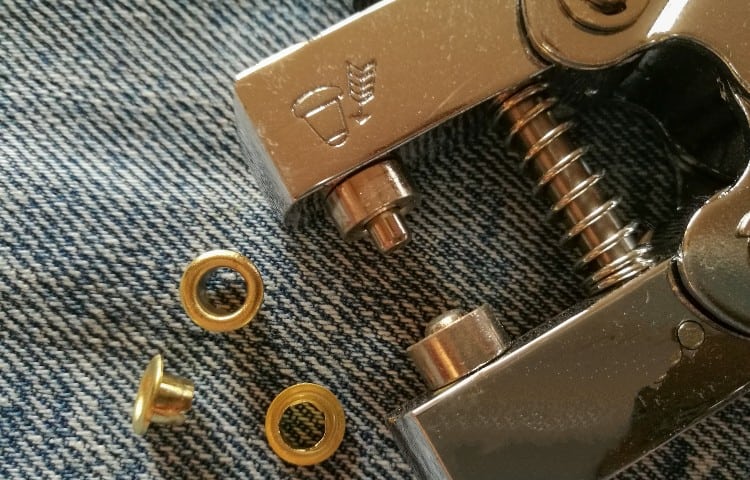
Like with a grommet, you’ll want to begin by marking your fabric where you want the eyelet to go. You’ll then want to make a hole in the fabric. Be careful not to make the hole larger than your eyelet.
Once the hole is made, insert the eyelet so that the ring is on the outside of the fabric. The shaft of the eyelet will go through the hole and be visible on the back.
Then, you will use the eyelet tool you have on hand to press the shaft into the fabric. This will bend the metal and compress it into place. You want to make sure the compressed metal comes fully in contact with the fabric, so it does not shift.
If you purchased an eyelet kit, you should have a flat tool included that you will use to compress the shaft. Simply line it up and hit the tool with a hammer to compress the metal into place.
If you are using pliers or a tabletop machine, insert the eyelet so that the ring lays in the flat part of the tool. Then, apply even pressure to compress the metal into place.
Are Grommets Permanent?
Yes, grommets are typically permanent as long as they are installed correctly. The two halves of the grommet will bond around the fabric, making them tremendously difficult to separate if you ever want to. However, if they aren’t properly installed, the two halves may not attach and can come loose.
Beyond that, the only things that could dislodge a grommet come from long-term wear and tear. Fabric will inevitably wear out, often long before the grommet does. It can easily tear, leaving the grommet behind.
Technically, the metal of a grommet could eventually be worn through, but this is unlikely unless it receives lots of wear over time.
Are Eyelets Permanent?
Eyelets are also typically permanent when installed correctly. However, it’s important to remember that they are usually less durable than grommets. They may wear out faster when used regularly since they aren’t meant to take as much wear and tear as grommets.
Why Did My Grommet or Eyelet Fall Out?
Occasionally, grommets or eyelets fall out due to improper installation. With grommets, the most common issue is that the two halves do not line up correctly. Because of this, they were not completely attached to each other and were able to separate.
Another common culprit is using too little or too much pressure during installation. For both grommets and eyelets, too little pressure during installation can mean they won’t fully grip the fabric. Too much pressure can cause the metal to be damaged, leading to issues with the grommet or eyelet down the road.
Beyond these reasons, grommets or eyelets can also fall out due to regular wear and tear. The fabric could rip, the grommet could get worn down, or something could get snagged in the hole. In cases like these, you will probably see damage to the area around the hole, which will clue you into the culprit.
Grommet vs Rivet
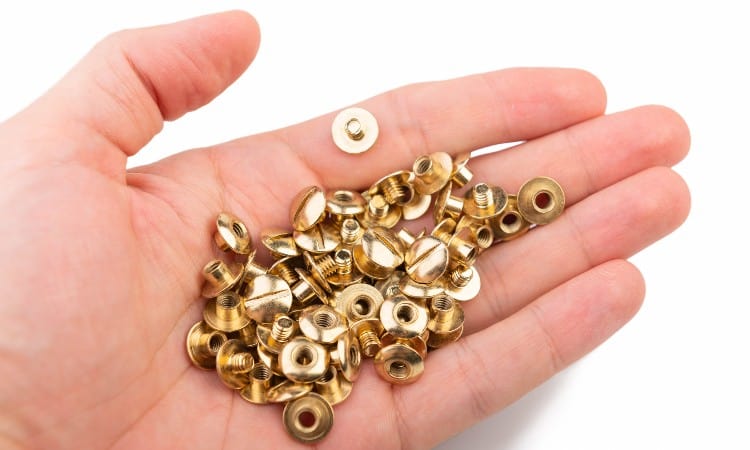
If you think back, we’ve mentioned that grommets are meant to reinforce the edges of a hole in the fabric. Because of this, a grommet will have an opening in the center to allow strings, cords, or other fixtures to pass through.
Rivets, on the other hand, do not generally have an opening in their center. However, like a grommet, rivets are installed by pressing together two pieces of metal. Rivets were originally created for mechanical purposes to adhere pieces of metal to one another.
Rivets are very heavy-duty and are permanent like grommets. They can be quite large and are often used to fasten together pieces of everyday objects. You’ll likely see rivets on everything from bridges to airplanes in your daily life.
You may also encounter decorative fashion rivets at your local craft store. These are often used as accents on clothing and, like their more industrial counterparts, will help to reinforce areas of the garment.
Conclusion
Grommets and eyelets are easy to confuse, but after reading this, you should have all you need to tell the difference between the two. Perhaps now you’ll consider adding them to your next project! If you do, keep this guide handy to help you figure out which option will suit your needs and how to install them properly.